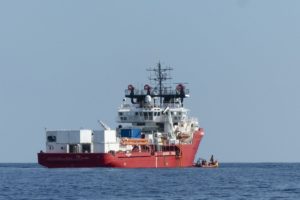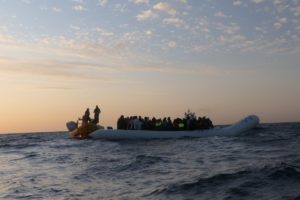BY SEAN HANSEN

Launched earlier this year, the Ocean Viking is a humanitarian rescue ship operated in partnership by SOS Mediterranee and Medicins san Frontieres in the Mediterranean Sea. Source: SOS Mediterranee.
Forty-two miles off the Libyan coastline, the Ocean Viking races towards a sinking ship full of refugees. Acting on information reported to the Libyan Coast Guard, the ship’s crew prepares for a rescue effort in the bleak hours of the morning.
“We had been trying to contact the Libyan Coast Guard to see if they agree for us to go,” says Francois Thomas, President of the humanitarian organization SOS Mediterranee, which operates the Viking. “But we didn’t receive an answer.”
The rescue ship goes ahead anyway.
At 6:40 a.m., the Viking makes visual contact with the boat in distress: a white, rubber raft, floating listlessly in the Mediterranean Sea. In it is a crowd of tightly packed humans, callously arranged to maximize the number of bodies piled in. Without life jackets, they each cling to the person in front of them. But many of them cannot swim.
***
The Viking has been at sea for several months, carrying out search-and-rescue operations in the international waters of the Mediterranean. Although the migration crisis peaked in 2016, recent shifts in European and Libyan border policies have perpetuated the tragedy today, making sea crossings deadlier than ever before. Operated in partnership with Medicins san Frontieres (MSF), the Ocean Viking is one of the only search-and-rescue vessels in the area devoted solely to rescue efforts in the Mediterranean today. But despite its crew’s good intentions, the Viking faces growing logistical and political challenges. Coordination with the Libyan Coast Guard is just one.
In an interview with al Jazeera, a Libyan Coast Guard Colonel questioned the role of NGOs like MSF and SOS in rescue efforts entirely. “Carrying out search and rescue operations in Libyan territory must be done with the Coast Guard’s permission,” he told al Jazeera. “But do we really need these NGOs working in this area? As long as NGOs are around, migration will continue.”
In many ways, the Libyan Coast Guard and European Union have succeeded in shutting down rescue NGOs in Libya’s search-and-rescue area. Intimidation tactics such as firing warning shots and harassing both migrant and rescue ships are routine. The environment is made more hostile by strict E.U. policies and practices of detaining rescue ships and embedding spies on board. While 10 NGO ships operated in 2017, there are just a handful today.
With or without rescue organizations, the migration crisis has persisted. Since 2014, more than 18,443 migrants have died attempting to cross the Mediterranean Sea – with an alarming 88% departing from Libya. This year alone, 1,235 migrants have perished attempting the ocean crossing.
SOS Mediterranee began its operations three years ago, at the height of the crisis in 2016. Since then, it has rescued over 30,000 refugees and migrants.
“The motivation is saving lives. Nothing more,” says Francois, a seasoned French sailor with decades of experience as a navy officer and in both the maritime shipping industry and humanitarian sector. “But the coordination is under the responsibility of the Libyan Coast Guard,” he adds. “So if they are closer than us, they will do the job, and they will bring back the rescued people to Libya. We have to be careful, of course, because we don’t want to risk the life of rescued people, or our seafarers.”
***
6:51 a.m. With no word from the Coast Guard, the Viking’s crew tries to contact the Libyan Joint Rescue Coordination Center via the ship’s satellite phone. “It’s the center to coordinate and organize a rescue,” says Francois. “But most of the time, they don’t answer us.”
By 7:00 a.m., there’s still no response. “There were several more times we called the Libyans,” Francois emphasizes. “But still — no answer.”
With no time to waste, the Viking’s captain makes the call to initiate the rescue without the explicit permission of Libyan authorities. “It’s a risk assessment,” Francois says. “If we don’t do the job, and we wait for the Libyan Coast Guard, the people in distress will die. They will drown.” It’s an easy choice.
At 7:15 a.m., the Viking’s crew deploys the rescue boats. Responders spring into action, carefully handing out life jackets and urging the raft’s inhabitants to remain still. With many migrants unable to swim, any sudden move could tip the boat and complicate the rescue.
One by one, crew members lift the most vulnerable off the floundering raft: four children under the age of five, followed by four pregnant women, and finally, 39 minors. In total, 95 survivors are pulled from the inflatable dinghy.
With no loss of life, the rescue is a major success.
But before there’s even a moment to pause, the Viking gets word of another boat in distress. In the following 48 hours, the Viking completes two more rescue operations. In just three days, the ship’s crew pull a total of 215 people out of the Mediterranean.
Crew from the Ocean Viking prepare to rescue 95 people from a rubber boat in distress. Source: SOS Mediterranee.

Crew from the Ocean Viking prepare to rescue 95 people from a rubber boat in distress. Source: SOS Mediterranee.
‘World’s Deadliest Sea Crossing’
Despite these rescue efforts, the death toll continues to mount for migrants fleeing Libya. Just days before the November 19 rescue, the Viking discovered a deflated raft floating 35 miles off of Libya’s coast. There were no survivors.
“It is a real drama, in fact,” Francois says somberly. “There are less fatalities this year compared to last year,” he cautions, “but the percentage of fatalities is higher compared to their arrival.”
Last year, six refugees died every day trying to reach Europe — making this 300-mile stretch between Libya and Italy the deadliest migrant route in the world. This year, the IOM estimates that 1,235 migrants have already drowned in the Mediterranean.
Making the crossing more dangerous today is the new reality that European Coast Guard vessels no longer conduct search-and-rescue missions, as part of a 2017 deal reached between the European Union and Libya. The arrangement provides that Italy and the E.U. pay $100 hundred million euros to finance the Libyan Coast Guard, in exchange for Libya tightening up its borders. It also specifies that Libyan authorities must return all rescued migrants to Libya, to newly established detention centers.
Human rights groups have widely criticized the agreement as inhumane.
In a letter to the Italian government last month, 21 international organizations wrote that “Italy and the entire European Union must be aware that they are implementing collective rejections of people fleeing war and persecution and that they are also financing the concentration camp system in Libya. All this recalls the most horrible pages of the history of the 20th century.”
Hajer Sharief, a prominent human rights activist in Libya and U.N.-appointed expert on youth, peace, and security calls the approach hypocritical. “I find it extremely ironic that most, if not all of the European countries, advise their citizens not to travel to Libya because of the security situation,” she tells me. “Yet when it comes to migration, they claim that it is safe enough to be treated as a host country; safe enough to have detention centers with migrants residing there,” she says.
***
9:34 a.m. Just as the Viking completes its rescue mission, Francois says the Libyan Coast Guard initiated communication and arrived on site. “They asked us to disembark the rescued people in Libya – in Tripoli or another Libyan port. But of course, we tell them no,” he says in frustration. “Because Libya is not considered a safe place — this is recognized by the United Nations, UNHCR, E.U., and so on.”
The resulting system of search-and-rescue has thus proven chaotic, with the Libyan Coast Guard often contesting rescues with vessels such as Ocean Viking, which refuses to return migrants and refugees to any Libyan port.
In a written statement just after the rescue, Nicholas Romaniuk — the Humanitarian Coordinator onboard the Ocean Viking — highlighted the gravity of circumstances today. “The situation in the Central Mediterranean, from my experience, is as worse as it has ever been over the last couple years. There is no coordination. There seems to be a complete disregard for potential loss of life regarding people fleeing Libya by boat.”
The different approaches to rescue efforts have led to the growing rift between humanitarian organizations such as SOS Mediterranee and the Libyan Coast Guard. Yet it is the refugees and migrants who suffer the most. They face an impossible choice of risking their lives, and often their life savings, in a perilous journey across the sea — or risking their lives by staying in a conflict-ridden Libya. As the number of migrants arriving in Europe continues to plummet, the reality is grim: more migrants are stuck in an unsafe Libya, and more migrants are perishing at sea.
***
“What is the Mediterranean Sea?” Francois asks. He pauses before continuing. “For many Europeans, it is a place of vacation, of holiday,” he says. “But actually, it is a real drama.”
For the thousands of migrants and refugees still stuck in Libya, the sea is the last obstacle preventing them from the safety and hope of a new life in Europe. With fighting in Tripoli intensifying to its worst level in years, migrants are increasingly desperate to flee. Despite Libya’s new border policies, the flow of migrants isn’t expected to stop any time soon. IOM estimates that there are as many as one million refugees and migrants still in Libya today — many of whom are unaccounted for.
Annabella is one of those waiting to leave. She fled from Edo State in Nigeria in 2017 amidst poverty and violence, and has been stuck in Libya since she lost her passport. Without a legal identity, she lives in a Tripoli apartment with several other Nigerian migrants, eager to leave behind the violence and uncertainty of Libya. She has friends that have crossed into Italy, and she plans to join them.
“When the weather is good, we will go,” she tells me. She’s saved enough money cleaning houses to afford the smugglers fee.
While she is aware of the risks, Annabella is desperate to leave Libya. “I have no other way,” she tells me over the phone. Without a passport, she cannot return to Nigeria without paying hefty fees. “It’s dangerous, I know,” she recognizes. “But I don’t have another way.”